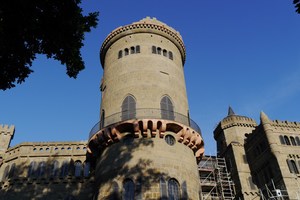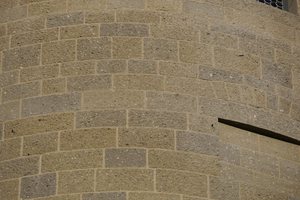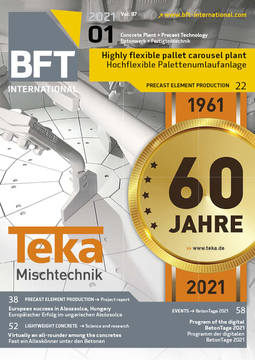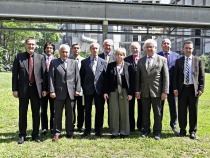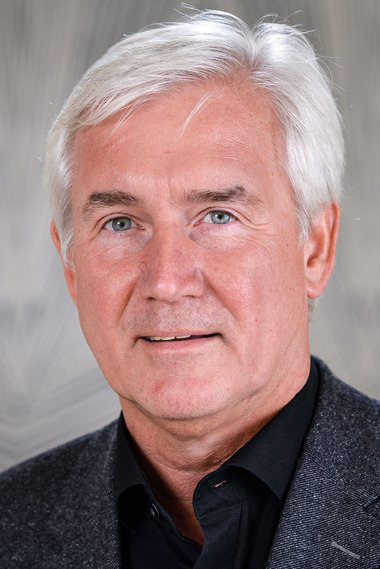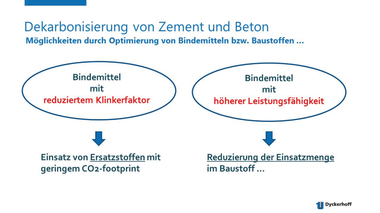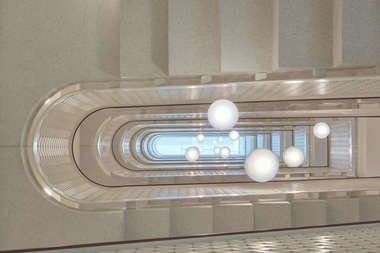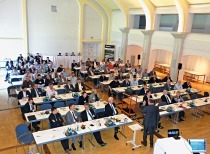Cast stone opens up new options in monument protection
The successful reconstruction of the belfry of Löwenburg castle in Kassel is a sensational example for the use of cast stone in the preservation of historical monuments. For a long time, Löwenburg castle, that was originally built of tuff, had led a dull existence as a permanent renovation case. Only the idea to use cast stone to reproduce the tuff gave rise to the impetus needed for the reconstruction. The mix design for the cast stone/concrete block developed at the Material Testing Institute of the University of Kassel is based on Dyckerhoff Weiss white cement as binder.
The artificial tuff was manufactured at the Bad Langensalza facility of Dyckerhoff Transportbeton Thüringen/Germany. The company in charge with the cast stone works, Denkmalpflege Mühlhausen Huschenbeth, had rented the mixing plant on 14 Saturdays in total. The principal raw material used in the mix design was tuff extracted from the Kuhberg hill near Kassel and crushed to aggregates with particles from 0.25 to 32 mm. Furthermore, basaltic lava, travertine and trass powder as well as the powder pigments iron oxide yellow and black were added to the formulation. In addition, 308 tons of Dyckerhoff Weiss Decor white cement were used as binder.
The mixed material was used to cast 282 tuff concrete blocks (in dimensions of 2 x 1 x 1 m),
which were cut into 4,500 unique masonry blocks in a meticulous process subsequently. Historical documents provided measurements and positions of the masonry blocks that were created as 3D models on the computer first. It took about two years for just one bricklayer of the Fulda-based company Enders to mason the entire tower. The Rajasil VMM mortar for facing brickwork of Heck Wall Systems located in Marktredwitz was used as masonry mortar.
Reconstruction with artificial tuff true to original
The former general manager of the Material Testing Institute of the University of Kassel, Peter Machner, already had the idea of the artificial tuff when working with natural tuff in 2009. „During the extraction of tuff, a lot of waste is produced which I intended to reuse,“ Machner stated. He added small crushed tuff rock as aggregates to a cement paste and was able to produce artificial tuff in this way.
Centuries after the actual construction phase of castles in Germany, Löwenburg castle had been built by the master builder Heinrich Christoph Jussow between 1793 and 1801. The building should imitate a medieval knight‘s castle and was therefore conceived as an artificial castle ruin right from the beginning. The Habichtswald tuff existing in the vicinity suggested itself as construction material. This dark rock highlighted the medieval character of a castle ruin and, moreover, it was easy to process. Immanent disadvantage: Tuff rock is not very durable by nature and therefore actually unsuitable for building construction.
Löwenburg castle is part of the UNESCO world heritage site of Bergpark Wilhelmshöhe. This property covering 560 hectares of architecture and garden art also comprises the Hercules Monument, the Wilhelmshöhe Palace and the historical water displays. Löwenburg castle was built as a residence of the Landgrave William IX (later Elector William I) of Hessen-Kassel for himself and his mistress Karoline von Schlotheim. From an art-historical perspective, Löwenburg castle is one of the first important buildings in neo-Gothic style in Germany and is therefore regarded as groundbreaking.
The 25m-tall belfry (the uninhabited main tower of a medieval castle – editor‘s note) of Löwenburg castle has already been reconstructed for the third time. The first large tower of the 18th century only lasted 50 years, then it collapsed. The second tower lasted until 1945, before – in a poor condition anyway – it fell victim to an aerial bomb during the last days of the war. Client of the reconstruction is the federal state of Hessen, start of construction works was in 2015.

